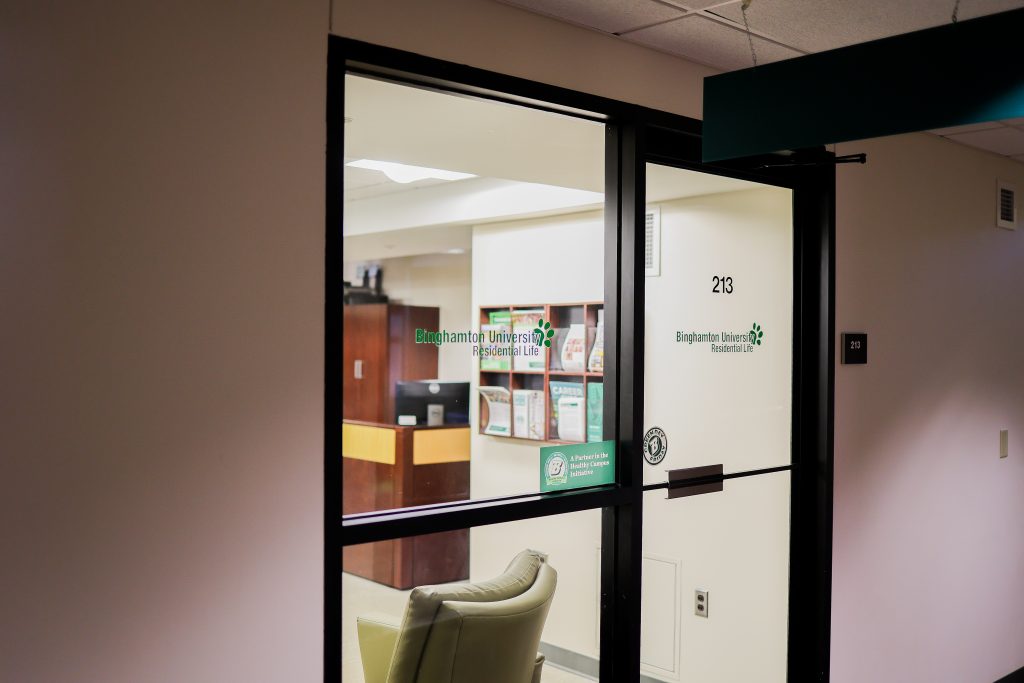Over 150 Binghamton University freshmen started the fall semester living in super occupancy housing (SOH) due to a lack of available living space for newly admitted students.
According to Residential Life, SOH refers to the temporary placement of three or more students in a living space originally designed to accommodate less than three individuals. SOH rooms are typically standard double rooms with an additional bed or dresser added to accommodate a third roommate. Students placed in SOH rooms are continually prioritized for relocation into a standard double room or suite. The Residential Life website notes that a majority of SOH residents are moved elsewhere before the end of the fall semester.
Casey Wall, the director of residential life and housing, discussed how Residential Life is currently relocating students.
“We opened the fall semester with 153 students living in super-occupied rooms and currently have 60 students still living in this kind of housing arrangement,” Wall wrote in an email. “Based upon past experience with [SOH], we anticipate that all students will be successfully re-assigned into their permanent room assignment by October, such that only those who wish to voluntarily remain in [SOH] will do so.”
The current need for SOH stems from a variety of factors — including an increase in both student applications and acceptances — as the University has accepted more students than campus has standard housing space for. BU received a record-breaking 49,500 undergraduate student applications for fall 2023, a 19 percent increase from the previous admissions year.
Benjamin Medina, a freshman double-majoring in economics and mathematics, spent his first two weeks in an SOH arrangement. He did not learn that he was being placed in SOH until he moved in.
“I didn’t know it was going to be [SOH],” Medina said. “I got there my first day, on [Aug. 20], and I got the top bunk because the other two people in the room got there first. So, it was basically like ‘first come, first served.’”
The Residential Life web page notes that a majority of SOH residents are moved elsewhere before the end of the fall semester. The time spent in SOH depends on how quickly standard housing rooms are made available. In addition to the growth of the student body, Wall identified other factors impacting available housing space.
“These include the number of returning students who select to stay in on-campus housing, the number of admitted students who enroll, the number of students who choose to withdraw, defer, no-show or transfer and the number of beds available in any given year based upon building renovations,” Wall wrote.
Students assigned to live in SOH are asked to select one of three colors at random to determine the set of furniture that they receive. To accommodate three residents, SOH students may be assigned either a single bed or one mattress on a bunk bed. While all three occupants have a dresser for storage, only one student gets access to a full closet, leaving the other two residents with a half closet to hang clothing and other belongings. While three students are expected to utilize the living space, only two desks are present in every SOH room. The third student can request that an extra desk and chair be provided, but there is no guarantee that a SOH room can accommodate a third desk.
The two desks already present in Medina’s room were claimed by his fellow roommates, leaving him without a desk and chair. He described other challenges that arose from three people sharing a space designed for only two.
“When I would climb into my bed, I would have to climb onto the desk of the guy who slept in the bunk under me, because the ladder to my top bunk didn’t work,” Medina said. “I would also just study in the common room or the living room, but I honestly could not do that much studying there.”
To further alleviate the housing shortage on campus, Residential Life says that it will continue monitoring the situation to determine whether new living spaces should be built. The office mentioned that Old Rafuse in the Old Dickinson Community, newly renovated, will reopen in January and will be able to house approximately 130 students.
Medina emphasized why fixing the on-campus housing shortage should be a priority for the University.
“It’s very important to have your own space — your own desk [and] your own bed where you can put your belongings and go back to for studying,” Medina said. “It should definitely be a [priority] to get the housing accommodations in order.”



